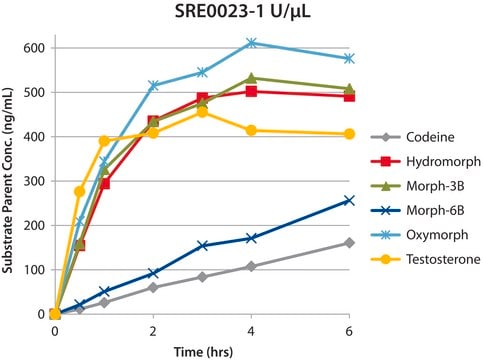G0376
β-Glucuronidase from bovine liver
Type B-3, ≥2,000,000 units/g solid
Synonym(s):
β-D-Glucuronide glucuronosohydrolase
Sign Into View Organizational & Contract Pricing
All Photos(4)
About This Item
Recommended Products
biological source
bovine liver
type
Type B-3
form
solid
specific activity
≥2,000,000 units/g solid
storage temp.
−20°C
Looking for similar products? Visit Product Comparison Guide
Application
β-glucuronidase is used as a reporter gene in GUS assays to monitor gene expression.
Biochem/physiol Actions
β-glucuronidase catalyzes the breakdown of complex carbohydrates. In humans it converts conjugated bilirubin into the unconjugated form, making bilirubin suitable for reabsorption.
Unit Definition
One Sigma or modified Fishman unit will liberate 1.0 μg of phenolphthalein from phenolphthalein glucuronide per hr at 37 °C at pH 5.0 (30 min assay).
Signal Word
Danger
Hazard Statements
Precautionary Statements
Hazard Classifications
Resp. Sens. 1 - Skin Sens. 1
Storage Class Code
11 - Combustible Solids
WGK
WGK 3
Flash Point(F)
Not applicable
Flash Point(C)
Not applicable
Personal Protective Equipment
dust mask type N95 (US), Eyeshields, Gloves
Certificates of Analysis (COA)
Search for Certificates of Analysis (COA) by entering the products Lot/Batch Number. Lot and Batch Numbers can be found on a product’s label following the words ‘Lot’ or ‘Batch’.
Already Own This Product?
Find documentation for the products that you have recently purchased in the Document Library.
Customers Also Viewed
Helena C Besse et al.
Pharmaceutics, 12(6) (2020-06-14)
The poor pharmacokinetics and selectivity of low-molecular-weight anticancer drugs contribute to the relatively low effectiveness of chemotherapy treatments. To improve the pharmacokinetics and selectivity of these treatments, the combination of a doxorubicin-glucuronide prodrug (DOX-propGA3) nanogel formulation and the liberation of
Amichay Meirovitz et al.
The FEBS journal, 280(10), 2307-2319 (2013-02-13)
Recent years have seen a growing body of evidence that enzymatic remodeling of heparan sulfate proteoglycans profoundly affects a variety of physiological and pathological processes, including inflammation, neovascularization, and tumor development. Heparanase is the sole mammalian endoglycosidase that cleaves heparan
Shu Feng et al.
Cancer research, 73(8), 2551-2562 (2013-02-27)
Prostate cancer is the most common visceral malignancy and the second leading cause of cancer deaths in US men. There is broad evidence that fibroblast growth factor (FGF) receptors are important in prostate cancer initiation and progression, but the contribution
Yongfeng Gao et al.
Plant molecular biology, 82(1-2), 131-145 (2013-03-19)
Alternative splicing can produce transcripts that encode proteins with altered functions. The transcripts of the ABSCISIC ACID INSENSITIVE3 (ABI3)/VIVIPAROUS1 (VP1) gene, which is an important component in abscisic acid (ABA) signaling, are subjected to alternative splicing in both monocotyledons and
Ying Wang et al.
Arteriosclerosis, thrombosis, and vascular biology, 33(5), 894-902 (2013-03-09)
After diabetes mellitus, transfer of lipoprotein lipase (LPL) from cardiomyocytes to the coronary lumen increases, and this requires liberation of LPL from the myocyte surface heparan sulfate proteoglycans with subsequent replenishment of this reservoir. At the lumen, LPL breaks down
Our team of scientists has experience in all areas of research including Life Science, Material Science, Chemical Synthesis, Chromatography, Analytical and many others.
Contact Technical Service








